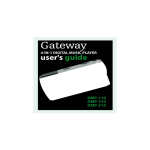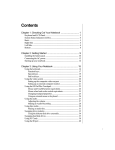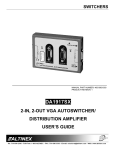Download Gateway 7250R User's Manual
Transcript
A MAN US 7250R RACKMOUNT GDE R0 4/00 7250R Server Rackmount Installation Guide 8506163.book Page i Wednesday, May 10, 2000 11:40 AM Contents Preface . . . . . . . . . . . . . . . . . . . . . . . . . . . . . . . . . . . . . . . . . . . . . . . . . . . . . . . . . . . . . iii Conventions used in this manual . . . . . . . . . . . . . . . . . . . . . . . . . . . . . . . . . . . . . . . iii Information about your system . . . . . . . . . . . . . . . . . . . . . . . . . . . . . . . . . . . . . . . . . iv Accessing the server system manual . . . . . . . . . . . . . . . . . . . . . . . . . . . . . . . . . iv Getting additional information . . . . . . . . . . . . . . . . . . . . . . . . . . . . . . . . . . . . . . . iv 1 Installation . . . . . . . . . . . . . . . . . . . . . . . . . . . . . . . . . . . . . . . . . . . . . . . . . . . . . . 1 Installing the system drawer side rails . . . . . . . . . . . . . . . . . . . . . . . . . . . . . . . . . . . 2 Installing the cabinet mounting brackets and mounting rails . . . . . . . . . . . . . . . . . . 3 Installing Gateway mounting brackets . . . . . . . . . . . . . . . . . . . . . . . . . . . . . . . . 3 Installing the cabinet mounting rails onto Gateway brackets . . . . . . . . . . . . . . . 4 Installing generic mounting brackets . . . . . . . . . . . . . . . . . . . . . . . . . . . . . . . . . 5 Installing the cabinet mounting rails onto generic brackets . . . . . . . . . . . . . . . . 7 Mounting the system drawer in the cabinet . . . . . . . . . . . . . . . . . . . . . . . . . . . . . . . 9 Installing the cable retractor . . . . . . . . . . . . . . . . . . . . . . . . . . . . . . . . . . . . . . . . . . 12 Installing a cable retractor in a Gateway cabinet . . . . . . . . . . . . . . . . . . . . . . . 12 Installing a cable retractor in a non-Gateway cabinet . . . . . . . . . . . . . . . . . . . 13 Attaching the cables to the retractor . . . . . . . . . . . . . . . . . . . . . . . . . . . . . . . . 14 Completing the connections . . . . . . . . . . . . . . . . . . . . . . . . . . . . . . . . . . . . . . . . . . 15 Connecting a single system drawer . . . . . . . . . . . . . . . . . . . . . . . . . . . . . . . . . 15 Connecting multiple system drawers . . . . . . . . . . . . . . . . . . . . . . . . . . . . . . . . 16 Connecting the power . . . . . . . . . . . . . . . . . . . . . . . . . . . . . . . . . . . . . . . . . . . . 18 Turning on the system drawer . . . . . . . . . . . . . . . . . . . . . . . . . . . . . . . . . . . . . . . . 19 Turning off the system drawer . . . . . . . . . . . . . . . . . . . . . . . . . . . . . . . . . . . . . . . . 20 Securing the system drawer in the cabinet . . . . . . . . . . . . . . . . . . . . . . . . . . . . . . 20 i 8506163.book Page ii Wednesday, May 10, 2000 11:40 AM Notices Copyright © 2000 Gateway, Inc. All Rights Reserved 4545 Town Centre Court San Diego, CA 92121 USA All rights reserved This publication is protected by copyright and all rights are reserved. No part of it may be reproduced or transmitted by any means or in any form, without prior consent in writing from Gateway. The information in this manual has been carefully checked and is believed to be accurate. However, changes are made periodically. These changes are incorporated in newer publication editions. Gateway may improve and/or change products described in this publication at any time. Due to continuing system improvements, Gateway is not responsible for inaccurate information which may appear in this manual. For the latest product updates, consult the Gateway Web site at www.gateway.com. In no event will Gateway be liable for direct, indirect, special, exemplary, incidental, or consequential damages resulting from any defect or omission in this manual, even if advised of the possibility of such damages. In the interest of continued product development, Gateway reserves the right to make improvements in this manual and the products it describes at any time, without notices or obligation. Trademark acknowledgments AnyKey, black-and-white spot design, CrystalScan, Destination, EZ Pad, EZ Point, Field Mouse, Solo, TelePath, Vivitron, stylized “G” design, and “You’ve got a friend in the business” slogan are registered trademarks and GATEWAY, Gateway Profile, Gateway Solo, Gateway Astro, green stylized GATEWAY, green stylized Gateway logo, and the black-and-white spotted box logo are trademarks of Gateway, Inc. Intel, Intel Inside logo, and Pentium are registered trademarks and MMX is a trademark of Intel Corporation. Microsoft, MS, MS-DOS, and Windows are trademarks or registered trademarks of Microsoft Corporation. All other product names mentioned herein are used for identification purposes only, and may be the trademarks or registered trademarks of their respective companies. ii 8506163.book Page iii Wednesday, May 10, 2000 11:40 AM Preface Conventions used in this manual Throughout this manual, you will see the following conventions: Convention Description ENTER Keyboard key names are printed in small capitals. CTRL+ALT+DEL A plus sign means to press the keys at the same time. Setup Commands to be entered, options to select, and messages that appear on your monitor are printed in bold. User’s Guide Names of publications are printed in italic. Important A note labeled important informs you of special circumstances. Caution A caution warns you of possible damage to equipment or loss of data. Warning A warning indicates the possibility of personal injury. Conventions used in this manual iii 8506163.book Page iv Wednesday, May 10, 2000 11:40 AM Information about your system Accessing the server system manual A comprehensive 7250R Server System Manual is located on the Server Companion CD, which accompanied this system. To access this document (in PDF format), place the 7250R Companion CD into the CD drive on a system running a Windows-based operating system, then follow the instructions on the Welcome screen. To get the latest updates to your system documentation, visit the technical support area of www.gatewayatwork.com. Getting additional information Visit the technical support area of www.gatewayatwork.com to find information about your system or other Gateway products. Some types of information you can access are: iv ■ Hardware driver and program updates ■ Technical tips ■ Service agreement information ■ Technical documents and component information ■ Frequently asked questions (FAQs) ■ Documentation for peripherals or optional components ■ Online technical support 8506163.book Page 1 Wednesday, May 10, 2000 11:40 AM Installation 1 This guide provides information on installing your Gateway server in a third party cabinet. The rackmount accessory kit includes: ■ 2 pairs of generic mounting brackets (short and long) ■ 2 28-inch (71.12 cm) cabinet slide rail assemblies ■ 1 cable retractor assembly ■ Assorted size screws ■ Miscellaneous hardware If you are installing the system drawer in a Gateway rack cabinet, you will need a separate mounting kit. The Gateway rackmount accessory kit (Part Number: 2509860) includes: ■ 2 pairs of Gateway mounting brackets (labeled FRONT and REAR) ■ 2 Gateway 28-inch (71.12 cm) cabinet slide rail assemblies ■ 1 cable retractor assembly ■ Assorted size screws ■ Miscellaneous hardware If you intend to install the 7250R Server in a Gateway rack cabinet and you did not receive the Gateway rackmount accessory kit, contact client care to get the correct accessory kit. 1 8506163.book Page 2 Wednesday, May 10, 2000 11:40 AM Installing the system drawer side rails Before installing the server (system drawer) in the cabinet, you need to install the system drawer side rails on the server. To install the system drawer side rails: 1 Remove the system drawer side rails from the cabinet mounting rails by depressing the retention clips on the inside of the system drawer side rails, then sliding the rails off. Retention clip 2 Mount the system drawer side rail on the server using three screws from the accessory kit. Make sure the retention clips are toward the back of the server. 3 Mount the second rail on the opposite side of the server. Retention clip System drawer side rail 2 Installation 8506163.book Page 3 Wednesday, May 10, 2000 11:40 AM Installing the cabinet mounting brackets and mounting rails If you are installing the server in a Gateway cabinet, refer to the following section. If you are installing the server in a non-Gateway cabinet, go to “Installing generic mounting brackets” on page 5. Installing Gateway mounting brackets If Gateway mounting brackets are already installed in the cabinet, go to “Installing the cabinet mounting rails onto Gateway brackets” on page 4. To install the Gateway mounting brackets in the cabinet: 1 If you received a mounting template with your cabinet, use it to locate the exact position of the cabinet mounting brackets. 2 Position the front mounting bracket (labeled FRONT) on the front vertical mounting rail. 3 Attach the front mounting bracket to the front vertical mounting rail using two screws from the accessory kit. Back mounting bracket Front mounting bracket Back vertical mounting rail Front vertical mounting rail Installing the cabinet mounting brackets and mounting rails 3 8506163.book Page 4 Wednesday, May 10, 2000 11:40 AM 4 Position the back mounting bracket (labeled REAR) on the back vertical mounting rail. 5 Attach the back mounting bracket to the back vertical mounting rail using two screws from the accessory kit. 6 Mount the second set of brackets on the opposite side of the cabinet by repeating Steps 2 through 5. Installing the cabinet mounting rails onto Gateway brackets To install the cabinet mounting rails onto Gateway brackets: 1 Align the back end of the cabinet mounting rail to the back mounting bracket by sliding the inner rail forward (if the spring latch locks the inner rail into place, free the rail by releasing the spring latch). Back mounting bracket Back vertical mounting rail Inner rail Front mounting bracket Spring latch Front vertical mounting rail 2 Attach the back end of the cabinet mounting rail to the back mounting bracket using a screw from the accessory kit. 4 Installation 8506163.book Page 5 Wednesday, May 10, 2000 11:40 AM 3 Align the front of the cabinet mounting rail to the front mounting bracket by sliding the inner rail and inner slide until the rail screw hole opening lines up with one of the front mounting bracket screw holes. Back mounting bracket Inner rail Front mounting bracket Spring latch Screw 4 Attach the front of the cabinet mounting rail to the front mounting bracket using a screw from the accessory kit. 5 Attach the second screw to the front mounting bracket by repeating Steps 3 and 4. 6 Mount the second cabinet mounting rail on the opposite side of the cabinet by repeating Steps 1 through 5. 7 Go to “Mounting the system drawer in the cabinet” on page 9. Installing generic mounting brackets If you are installing the server in a non-Gateway cabinet, use the generic mounting brackets. These brackets allow for different cabinet depths. If generic mounting brackets are already installed in the cabinet, go to “Installing the cabinet mounting rails onto generic brackets” on page 7. Installing the cabinet mounting brackets and mounting rails 5 8506163.book Page 6 Wednesday, May 10, 2000 11:40 AM To install the generic mounting brackets in the cabinet: 1 If you received a mounting template with your cabinet, use it to locate the exact position of the cabinet mounting brackets. 2 Position the front mounting bracket (shorter bracket) on the front vertical mounting rail. 3 Attach the front mounting bracket to the front vertical mounting rail using two screws from the accessory kit. If screw holes in the front vertical mounting rail are not threaded, attach the front mounting bracket by using the screws and bar nut from the accessory kit. Bar nuts Back mounting bracket Front mounting bracket 4 Position the back mounting bracket (longer bracket) on the back vertical mounting rail. 5 Attach the back mounting bracket to the back vertical mounting rail using two screws from the accessory kit. If screw holes in the back vertical mounting rail are not threaded, attach the back mounting bracket by using the screws and bar nut from the accessory kit. 6 Mount the second set of brackets on the opposite side of the cabinet by repeating Steps 2 through 5. 6 Installation 8506163.book Page 7 Wednesday, May 10, 2000 11:40 AM Installing the cabinet mounting rails onto generic brackets To install the cabinet mounting rails onto generic brackets: 1 Align the back end of the cabinet mounting rail to the back mounting bracket by sliding the inner rail forward (if the spring latch locks the inner rail into place, free the rail by releasing the spring latch). Star washer Hex nut Back mounting bracket Spring latch Inner slide Inner rail 2 Attach the back end of the cabinet mounting rail to the back mounting bracket using two screws, hex nuts, and star washers from the accessory kit. One screw must be located in the last back bracket screw hole. The second screw can be located in any of the other back bracket long screw holes. Installing the cabinet mounting brackets and mounting rails 7 8506163.book Page 8 Wednesday, May 10, 2000 11:40 AM 3 Align the front of the cabinet mounting rail to the front mounting bracket by sliding the inner rail and inner slide until the rail screw hole opening lines up with the first inner rail screw hole and with the second screw hole on the front mounting bracket. Inner rail Front mounting bracket Inner slide Cabinet mounting rail Screw 4 Attach the front of the cabinet mounting rail to the front mounting bracket using a screw from the accessory kit. 5 Slide the inner rail and the inner slide again until the rail screw hole opening lines up with the front mounting bracket long screw hole. 6 Attach the front of the cabinet mounting rail to the front mounting bracket using a screw from the accessory kit. 7 Mount the second cabinet mounting rail on the opposite side of the cabinet by repeating Steps 1 through 6. 8 Installation 8506163.book Page 9 Wednesday, May 10, 2000 11:40 AM Mounting the system drawer in the cabinet To mount the system drawer in the cabinet: 1 Pull both of the inner rails forward until the spring latches on each side lock. 2 Pull the inner slides all the way forward. Inner rail Inner slide Spring latch Mounting the system drawer in the cabinet 9 8506163.book Page 10 Wednesday, May 10, 2000 11:40 AM 3 Lift the system drawer to the same height as the inner rails, then align the system drawer side rails with the inner rails. Warning In order to avoid injury or dropping the server, Gateway recommends that two people lift the system drawer. Inner rail System drawer side rail 4 Push the system drawer evenly into the cabinet until the latches on the system drawer side rails lock. 10 Installation 8506163.book Page 11 Wednesday, May 10, 2000 11:40 AM 5 Press the latches on both sides of the system drawer side rails, then push the system drawer back until the inner rail spring latches lock. System drawer side rail latch 6 From the back side of the cabinet, release the spring latch on the inner rail while pushing the system drawer to the back of the cabinet. The first time the system drawer is pushed back into the cabinet there may be some restriction of movement. The drawer should move smoothly, without binding or restriction thereafter. If there is still restriction of movement, make sure all rails and brackets are aligned properly. Mounting the system drawer in the cabinet 11 8506163.book Page 12 Wednesday, May 10, 2000 11:40 AM Installing the cable retractor Cable retractors reduce strain on the drawer cables and connectors and simplify maintenance because they keep the cables out of the way. If you are installing a cable retractor in a Gateway cabinet, refer to the following section. If you are installing a cable retractor in a non-Gateway cabinet, go to “Installing a cable retractor in a non-Gateway cabinet” on page 13. Installing a cable retractor in a Gateway cabinet To install a cable retractor in a Gateway cabinet: 1 Position the cable retractor adapter bracket on the back vertical mounting rail, then align the mounting holes on both the adapter bracket and the back vertical mounting rail. 2 Attach the adapter bracket to the back vertical mounting rail using two screws from the accessory kit. Back vertical mounting rail Adapter bracket Cable retractor 3 Go to “Attaching the cables to the retractor” on page 14. 12 Installation 8506163.book Page 13 Wednesday, May 10, 2000 11:40 AM Installing a cable retractor in a non-Gateway cabinet To install a cable retractor in a non-Gateway cabinet: 1 Remove the adapter bracket from the cable retractor straight bracket. Adapter bracket Straight bracket 2 Position the cable retractor straight bracket on the back vertical mounting rail, then align the mounting holes on both the cable retractor bracket and the back vertical mounting rail. 3 Attach the bracket to the back vertical mounting rail using a bar nut and screws from the accessory kit. Back vertical mounting rail Bar nut Straight bracket Cable retractor Installing the cable retractor 13 8506163.book Page 14 Wednesday, May 10, 2000 11:40 AM Attaching the cables to the retractor To attach the cables: 1 Route the cables from the rear of the system drawer to the cable retractor. 2 Attach the cables to the cable retractor, making sure the cables have sufficient slack when the system drawer is pulled forward and pushed back into place. Cable retractor Cable 3 Route the cables to their destinations and attach as necessary. 4 If necessary, bundle any excess cable. 14 Installation 8506163.book Page 15 Wednesday, May 10, 2000 11:40 AM Completing the connections When the system drawer is installed in the cabinet, make the system connections. Important A wide variety of system connections are possible. Your actual system connections may be different from the following examples. Connecting a single system drawer To connect the peripherals: 1 Turn off all system drawers and devices in the cabinet before attaching any of the system drawer cables. 2 Connect all I/O device cables (keyboard, mouse, video, serial, and parallel) to their respective ports on the back of the system drawer. The system board connectors may appear different than in the illustration, depending on your system board. To power source SCSI bus To monitor or KVM tray Mouse To printer Keyboard Tape storage drawer KVM or keyboard tray Completing the connections 15 8506163.book Page 16 Wednesday, May 10, 2000 11:40 AM Connecting multiple system drawers Multiple system drawers installed in a cabinet can share a single set of peripherals if a switch box, such as an autoswitcher, is installed. The autoswitcher gives control of the monitor and routes the keyboard and mouse inputs to the currently selected system drawer. Installation of the autoswitcher is relatively simple and covered in detail in the autoswitcher user manual. To connect multiple system drawers: 1 Turn off all system drawers and devices in the cabinet before attaching any of the system drawer cables. 2 If the newly installed system drawer will control other drawers in the cabinet, connect the external data cables of the controller cards to the controlled devices. 3 Connect all I/O device cables (keyboard, mouse, video, serial, and parallel) to their respective ports on the back of the system drawer. The system I/O connectors may appear different than in the illustration, depending on the system board installed in the server. If connecting multiple system drawers, use extender cables to link each system drawer to the autoswitcher. You must also attach the peripherals to the appropriate I/O ports on the back of the autoswitcher. Refer to the following figure for connection details. 16 Installation 8506163.book Page 17 Wednesday, May 10, 2000 11:40 AM Tape storage drawer SCSI channel 1 To power 7250R VGA video signal Mouse Keyboard Autoswitcher To power source KVM tray VGA video signal Tape storage drawer To printer To power source SCSI channel 2 SCSI channel 1 DataStation 8 storage drawer Completing the connections 17 8506163.book Page 18 Wednesday, May 10, 2000 11:40 AM Connecting the power Gateway recommends that a licensed electrician install a dedicated 230 VAC line, with sufficient amperage rating for the system drawer, to a breaker box or distribution panel. The power cords must be wired directly into the breaker box. If you use 115 VAC, make sure not to overload any power strip or wall outlet. Observe the following guidelines: ■ Only one system drawer per power strip (15 or 20 amps) or wall outlet (15 or 20 amps). For critical applications, plug the system drawer power cords into separate circuits. ■ If an uninterruptible power supply (UPS) is installed, plug only one CPU drawer into it. The power cords must be routed through the cabinet floor opening and to the system drawer. Make sure that the electrical current demands are balanced and that the system is properly grounded. Depending on the plug-in configuration, the following devices may share the same power strip: Plug-in Configuration Power Strip Total Supported Devices 230 VAC 15 amp ■ System drawer QHS storage drawer ■ Tape storage drawer Total must not exceed 12 amps ■ 20 amp System drawer QHS storage drawer ■ Tape storage drawer ■ Monitor ■ autoswitcher Total must not exceed 12 amps ■ ■ 115 VAC 18 Installation 15 amp ■ System drawer only 20 amp ■ System drawer with other peripherals not to exceed a total of 16 amps for the whole strip. 8506163.book Page 19 Wednesday, May 10, 2000 11:40 AM Turning on the system drawer To turn on the system drawer for the first time: 1 If using a UPS, turn it on first. 2 Turn on the monitor and any additional devices connected to the system drawer. Listen for alarms which may indicate power problems. 3 If multiple system drawers and a switch box are installed, press the switch box button that corresponds to the system drawer being turned on. 4 Press the ON/OFF button on the system drawer. Important If multiple system drawers are installed, you must turn on each system drawer and wait for it to start completely before turning on the next system drawer. 5 Listen for alarms which may indicate power problems. 6 Make sure the power indicator is illuminated. The monitor should display the normal Power On Self-Test (POST) information. If the monitor does not display information or the system drawer indicates an error has occurred, refer to the server system manual troubleshooting section. 7 When the system drawer starts successfully, install the operating system, if necessary. 8 Turn on the other system drawers by repeating Steps 3 through 7 for each additional system drawer installed. After this procedure, the system drawer can be turned on using normal start sequences. To turn on the system drawer using normal start sequences: 1 Turn on devices and drawers attached to the system drawer first. 2 When the devices and drawers attached to the system drawer are running, turn on the system drawer. Turning on the system drawer 19 8506163.book Page 20 Wednesday, May 10, 2000 11:40 AM Turning off the system drawer To turn off the system drawer: 1 Close all programs. 2 If necessary, issue a “flush” command to write the contents of any caches or buffers to disk. 3 If necessary, issue a command to exit or quit the operating system. 4 Press the on/off switch on the system drawer. 5 Turn off any other devices connected to the system drawer. Securing the system drawer in the cabinet To secure the system drawer: 1 Close the back door of the system cabinet, then lock it if necessary. 2 Push the system drawer all the way back into the cabinet until the front panel presses against the front vertical mounting rails. 3 Secure the system drawer to the front vertical mounting rails using four screws from the accessory kit. 4 Close the front cabinet door, then lock it if necessary. 20 Installation A MAN US 7250R RACKMOUNT GDE R0 4/00 7250R Server Rackmount Installation Guide






































